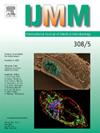广州医院废水中与临床感染相关的vanA/ vanm阳性万古霉素耐药屎肠球菌的出现:一项基因组流行病学研究
IF 3.6
3区 医学
Q1 MICROBIOLOGY
引用次数: 0
摘要
新出现的ST80耐万古霉素屎肠球菌(VREfm)谱系与中国和日本临床感染的增加有关,引起了人们对环境传播的担忧。医院废水系统是公认的抗微生物耐药细菌的储存库,但它们在传播ST80 VREfm中的作用尚不清楚。本研究调查了医院废水中VREfm的患病率以及患者与医院废水之间的基因组联系。方法于2023年12月至2024年5月在广州市3家医院采集废水样本262份。用万古霉素补充培养基鉴定VREfm。采用肉汤稀释法进行药敏试验。在同一家医院纳入了95个患者来源的VREfm基因组。全基因组测序和生物信息学分析揭示了基因组特征和遗传传递联系。结果vrefm检出率为54.6% %(143/262)。所有分离株均携带vanA,其中共有vanA和vanM的比例为25.9 %(37/143)。优势ST80谱系(43.4% %,n = 62)与最近的区域流行有关。属于CC17的新型序列类型ST2460是第二常见的(27.2 %,n = 39)。ST80菌株表现出丰富的耐药基因,与多药耐药表型和高耐药率相关。基因组分析显示,95.7 %(132/138)来自废水和患者的ST80分离株表现出密切的遗传亲缘关系(SNP中位数= 19,IQR: 14-23),并且在跨源传播网络中连接,这是由共享的p23vre019样质粒的高度相似性所支持的。结论医院废水是VREfm高危克隆的重要宿主,尤其是与疫情相关的ST80谱系。废水中持续存在的VREfm和跨源传播的证据突出表明迫切需要加强环境监测。应对环境油藏的综合战略对于应对日益严重的VREfm威胁至关重要。本文章由计算机程序翻译,如有差异,请以英文原文为准。
Occurrence of vanA/vanM-positive vancomycin-resistant Enterococcus faecium in hospital wastewater associated with clinical infections in Guangzhou, China: A genomic epidemiological study
Background
The emerging ST80 vancomycin-resistant Enterococcus faecium (VREfm) lineage, linked to the increases of clinical infections in China and Japan, raises concerns about environmental transmission. Hospital wastewater systems are recognized reservoirs for antimicrobial-resistant bacteria, but their role in disseminating ST80 VREfm remains unclear. This study investigates VREfm prevalence in hospital wastewater and genomic links between patients and hospital wastewater.
Methods
From December 2023 to May 2024, a total of 262 wastewater samples were collected from three hospitals in Guangzhou, China. VREfm was identified using vancomycin-supplemented media. Antimicrobial susceptibility was assessed using the broth dilution method. Ninety-five patient-derived VREfm genomes in the same hospitals were included. Whole-genome sequencing and bioinformatic analysis were performed to reveal genomic characterizations and genetic transmission links.
Results
VREfm was detected in 54.6 % (143/262) of samples. All isolates carried vanA, with 25.9 % (37/143) co-harboring vanA and vanM. The dominant ST80 lineage (43.4 %, n = 62) was linked to recent regional prevalence. A novel sequence type ST2460, belonging to CC17, emerged as the second most prevalent (27.2 %, n = 39). ST80 isolates exhibited enriched antimicrobial resistance genes, correlating with multidrug resistance phenotypes and high resistance rates. Genomic analysis revealed that 95.7 % (132/138) of ST80 isolates from wastewater and patients exhibited close genetic relatedness (median of SNP = 19, IQR: 14–23) and were linked within cross-source transmission networks, supported by the high similarity of a shared p23VRE019-like plasmid.
Conclusions
Hospital wastewater is a critical reservoir for high-risk VREfm clones, particularly the outbreak-associated ST80 lineage. The persistence of VREfm in effluents and evidence of cross-source transmission underscores the urgent need for enhanced environmental surveillance. Integrated strategies addressing environmental reservoirs are essential to combat the growing threat of VREfm.
求助全文
通过发布文献求助,成功后即可免费获取论文全文。
去求助
来源期刊
CiteScore
9.70
自引率
0.00%
发文量
18
审稿时长
45 days
期刊介绍:
Pathogen genome sequencing projects have provided a wealth of data that need to be set in context to pathogenicity and the outcome of infections. In addition, the interplay between a pathogen and its host cell has become increasingly important to understand and interfere with diseases caused by microbial pathogens. IJMM meets these needs by focussing on genome and proteome analyses, studies dealing with the molecular mechanisms of pathogenicity and the evolution of pathogenic agents, the interactions between pathogens and host cells ("cellular microbiology"), and molecular epidemiology. To help the reader keeping up with the rapidly evolving new findings in the field of medical microbiology, IJMM publishes original articles, case studies and topical, state-of-the-art mini-reviews in a well balanced fashion. All articles are strictly peer-reviewed. Important topics are reinforced by 2 special issues per year dedicated to a particular theme. Finally, at irregular intervals, current opinions on recent or future developments in medical microbiology are presented in an editorial section.

 求助内容:
求助内容: 应助结果提醒方式:
应助结果提醒方式:


